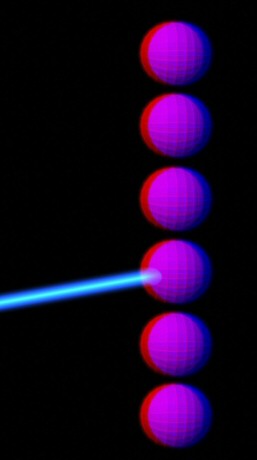1 December 2005
Atoms Coaxed Into Quantum "Cat" State
by Kate Melville
 In a demonstration of just how weird the quantum world is, scientists at the National Institute of Standards and Technology (NIST) have manipulated six atoms into spinning together in two opposite directions at the same time. This so-called Schrödinger "cat" state was achieved by entangling six beryllium ions (charged atoms) so that their nuclei were collectively spinning clockwise and counterclockwise at the same time.
In a demonstration of just how weird the quantum world is, scientists at the National Institute of Standards and Technology (NIST) have manipulated six atoms into spinning together in two opposite directions at the same time. This so-called Schrödinger "cat" state was achieved by entangling six beryllium ions (charged atoms) so that their nuclei were collectively spinning clockwise and counterclockwise at the same time.
The experiment, described in Nature, is a clear demonstration of the quantum concept of entanglement, which occurs when the quantum properties of two or more particles are correlated, and which Albert Einstein called "spooky action at a distance."
Existing in two states at once is a peculiar property of quantum physics known as superposition. The ions in this experiment were placed in the most extreme superposition of spin states possible with six ions. All six nuclei are spinning in one direction and the opposite direction simultaneously, in what physicists call Schrödinger cat states. The name was coined 80 years ago by German physicist Erwin Schrödinger who described an extreme theoretical case of being in two states simultaneously, namely a cat that is both dead and alive at the same time.
But cats are never observed in such states in the macroscopic "real world," so physicists believe that there is a boundary where the strange properties of quantum mechanics - the rule book for Nature's smallest particles - give way to the physical laws that govern our everyday experience. While the NIST experiment is a long way short of full entanglement of a real cat's roughly 1026 atoms, it extends the domain where Schrödinger cat states can exist to at least six atoms.
To create their six-atom cat state, the NIST researchers used an electromagnetic trap to hold the ions a few micrometers apart while an ultraviolet laser cooled the ions to near absolute zero. The cat states last about 50 microseconds and the researchers say they have run the experiment successfully tens of thousands of times, including numerous runs that entangled four and five ions.
Cat states, because they are superpositions of opposite overall properties that are relatively easy to verify, could be useful in fault-tolerant quantum computers. Also, cat states are more sensitive to disturbance than other types of superpositions, a potentially useful feature in certain forms of quantum encryption. The entangled cat states created by the NIST researchers also might be used to improve precision instruments, such as atomic clocks or interferometers that measure microscopic distances. Six ions entangled in a cat state are about 2.5 times more sensitive to external magnetic fields than six unentangled ions, offering the possibility of better magnetic field sensors, or better frequency sensors, which are components of atomic clocks.
Check out the purrrrfect video
Source: National Institute of Standards and Technology
Pic courtesy National Institute of Standards and Technology
